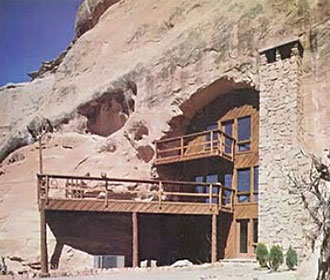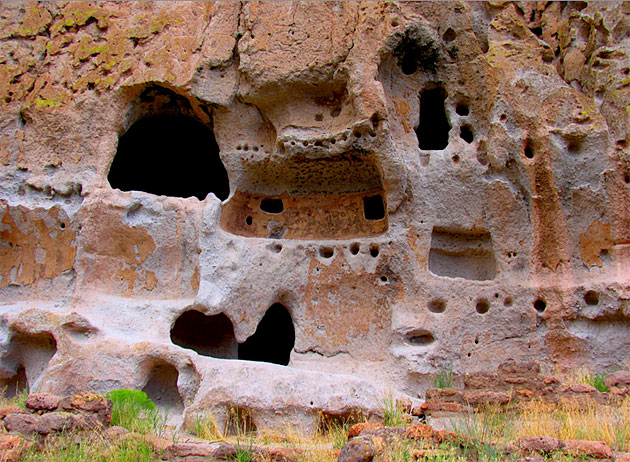Cliff Dwellings
Cliff dwellings (the stone villages that occupied huge shelves
on canyon walls) are the cornerstone of Anasazi architecture.
Before there was much knowledge about the occupants of locations
such as Mesa Verde, the builders of these ancient dwellings were
referred to simply as "cliff dwellers." These are the
most impressive examples of Anasazi architecture, but they represent
under 10-percent of Anasazi dwellings constructed between 1200
BC and the end of the Anasazi period circa 1300 AD.
 Charles Nystrom's Modern Cliff House
Charles Nystrom's Modern Cliff House |
|
Nestled facing southwest in Mesozoic sandstone is a cliff dwelling
of the twentieth century. Charles Nystrom has a rock-sheltered
house (pictured above) that gives him protection from the temperature
extremes of the climate in the high desert. It also suits his
individual spirituality.
A friend had suggested the
idea of a modern cliff dwelling to Nystrom and
he simply couldn't put it out of his mind. He researched cliff
and cave houses for five years so that he could develop a proper
design. It needed to combine efficiency, security and brightness,
while still showing the look of the earliest cliff dwellings.
When he retired from his contracting business in 1976, he put
his ideas into stone - literally.
On his property, no natural openings existed that would give
him enough room for his home. A demolitions expert for a mining
company blasted out rock - slowly - and it took two months to
open a suitable sized hole in the rock.
After the excavation had been completed, the three story, 1920-square
foot interior was less difficult to build than an open floor plan
house. Cave houses only need protection from the weather on the
exposed side, so Nystrom didn't have to insulate the ceiling,
floor or walls.
The portion of the home
that he constructed was made with 2 X 4 stud walls
on a 16 inch center. It has plywood on its outside and drywall
inside. An air space surrounds the walls, from two to three feet
wide, and the floor and ceiling as well, so that plumbing, ducting
and electrical connections could be installed and serviced as
needed.

Ancient Cliff Dwellings in New Mexico
Nystrom wasn't sure if humidity would represent issues in his
cliff dwelling. But the surrounding sandstone was porous, and
he installed a vapor barrier between wall and rock, and this has
been sufficient to prevent any problems.
His home also has closets, bureaus and cabinets recessed into
that dead air space that surrounds the walls. So, the interior
is uncluttered, leaving lots of floor space that would not be
attainable with conventional construction methods.
Cliff dwellings offer savings in labor and materials, so the
cost for a structure of this type is roughly the same as it would
be for a conventional home, built to high quality standards. Nystrom
hopes to improve the technique cost by using hydraulic mining
methods to make the "holes" for houses.
The construction of a cliff
dwelling could be done by a modern building contractor
or a very skilled do-it-yourselfer. Once the hole has been prepared,
the rest of the construction is not as complicated as building
a standard home.

House Built into a Cliff
Nystrom's house pays off when it comes to utility bills. His
average cooling and heating expense in the western Colorado slope
area is only 34 cents a day, or roughly $125 a year. This is about
1/10th of what it costs for an average tract home.
The electricity that he consumes serves a heat pump, which Nystrom
has installed on a meter of its own, so that he can track his
home's ultra-efficient energy usage.
Conclusion
From ancient times, to modern, cliff dwellings are starting to
make a comeback in the alternative living circles.
|

